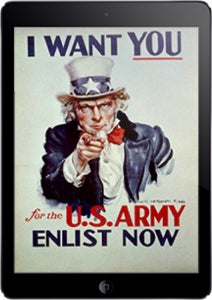Posted by Greg Reeder, Director of DoD Technology Solutions
A Few Good Men
Picture yourself in a bar. No, the Super Bowl isn’t being broadcast on an enormous screen. The place isn’t filled with the sounds of jager bombs being poured, happy hour, or collective sing-a-longs to Journey’s “Don’t Stop Believin’.” The bar is, instead, a small tavern in Philadelphia. The year is 1775, and one of the first, soon-to-be U.S. military recruiting campaigns is taking place: to motivate “able-bodied, sober, intelligent men” to become Marines.
The most successful recruiting campaign in U.S. history, however, involved the iconic Uncle Sam in a poster, exclaiming his desire for Americans to serve. Millions of the goatee-sporting posters were printed between 1917 and 1918, to bolster support for World War I and again during World War II.
Since the days of Uncle Sam, though, the basic requirement of finding Americans for service hasn’t changed. And unfortunately, in many ways, neither has the government’s approach or process to do so.
Today, the U.S. military services must put in place 200,000 men and women each year to maintain a baseline of U.S. forces. These new service members must not only pass basic training, but are required to meet stringent entry test standards, be physically fit, of good moral character and capable of doing tough jobs.
Finding “The Right Stuff” is Tough
The difficult task of recruiting qualified citizens isn’t limited to the military. The Department of Homeland Security, Health and Human Services, and all facets of government are challenged to find technologically capable, educated, dedicated people to fill myriad roles ranging from law enforcement to health care to cyber security.
It just so happens, the Americans whom the government needs are the exact same people who colleges, corporations and business everywhere are vying to attract. Now, pile on internal bureaucratic red tape created as a result of traditional recruiting methods:
- Disconnected systems that prevent collaboration between the marketing / advertising agencies hired to support recruiting efforts and the government staff tasked with finding the right people
- Outdated, lengthy, arduous forms-based accession rules and processes
- Congressional inquiries into recruiting funds and mandates for budget audits to determine cost effectiveness of recruiting efforts
Layer on some of the audience variables faced by recruiters and their agencies who help to build awareness, engagement and conversion:
- Actual and perceived military threats
- National economic performance
- Influencer perspectives
- Unemployment rates
- Media coverage
- Age distribution
- Education levels
- Gender equality
- College opportunities
Lastly, consider the 75 million or more U.S. millennials who, as a general rule, seek out and respond to high-touch, fast, frictionless, immersive digital experiences on multiple platforms – and are not impacted greatly by national television and newspaper ads. Unfortunately, focusing on TV and print ads is a long-time habit that is hard to break.
There is an enormous divide for recruiters and their advertising agencies to overcome.
“Any sufficiently advanced technology is equivalent to magic.” (-Arthur C. Clarke)
This collective storm of recruiting obstacles can be tackled through technology that would be viewed as magic by good, old Uncle Sam. Government leaders and their supporting ad agencies can start by reimagining the traditional process into one that is based on digital experiences and digital strategy. The first step is to change the recruiting process with new marketing and tech capabilities that will ensure:
No more slogan #fails: through improved and tailored personal digital experiences for the desired audience.
The end of herding cats: by enabling seamless collaboration between government & advertising agencies on content development.
Eliminating ineffective ad spends (for Battlestar Galactica – aka: TV): Ad agencies can optimize recruiting dollars for media spends to attract a more pinpointed audience – helping narrow the field of possible candidates at a lower cost than traditional advertising methods.
Saying goodbye to filling out forms, over, and over, and …. Adopting and implementing adaptive forms can save millions of dollars in processing costs, improve information and records management accuracy and security, streamline onboarding performance and even offer improved validation with better tech such as biometric signatures.
Talking to people where they are. With improved mobile, online and connected experiences that will engage, communicate, interact, and share information with potential candidates.
You Can be a Know-It-All: in a good way. The biggest piece of the puzzle missing from the recruiting process today, is a collective ability to know how marketing, ad awareness building, contact, interview, review & accessions processes all tie together, perform and produce results (or potentially miss their target). Having a fully capable, end-to-end analytics capability is paramount. The complexity of the modern (and highly competitive) recruiting process demands an effective way to track, measure, and report on the entire ecosystem.
Good to Go and Squared Away
Transitioning ad agencies and the government to a modern recruiting force is Not Just a Job, It’s an Adventure. Be All You Can Be, one of a Few Good Men or women who will Aim High and adopt technology that improves upon old methods, reduces costs, streamlines the onboarding process and ultimately identifies a highly qualified group of Americans with the desire to serve. Uncle Sam will be proud.
Suggested Links:
Adobe Marketing Cloud
Adobe Experience Manager (Sites, Assets, Mobile, Communities, Forms)
Adobe Media Optimizer
Adobe Analytics
Adobe Social
Adobe Campaign
Adobe Audience Manager
Suggested White Papers:
Adobe solutions for military digital recruiting
Optimize digital experiences to accelerate recruiting performance

